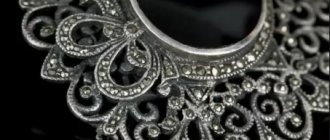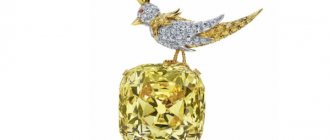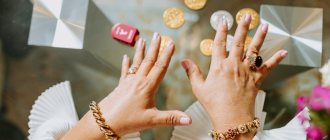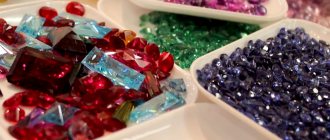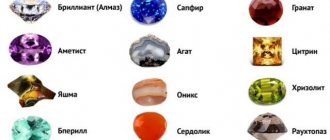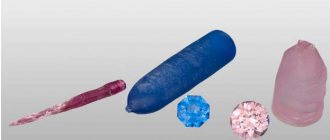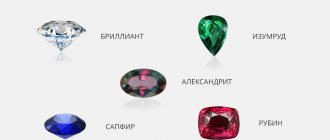Traditional women's jewelry: Japan August 26, 2013, 00:00 | Galina Zamyslova
18 chosen
Traditional Japanese women's costume did not allow jewelry on the arms or necklaces. What kind of women's jewelry will we be talking about then? The main decoration about 400 years ago was the hairstyle! Hair jewelry has become the main way of self-expression and demonstration of wealth and status. Hair jewelry received a name - kanzashi (kanzashi) and became real works of art. Their diversity in purpose and execution is such that you may need a separate dictionary with descriptions to figure out which jewelry is for which lady, when and where it can be worn, and even at what time of year, and at what age! In Japan, everything has a deep meaning - even ladies' heels!
Why did the history of Japanese women's jewelry begin exactly 400 years ago? Before this, the hairstyle was very simple - smoothly combed taregami hair, but at the end of the Heian era, court ladies changed their hairstyles to nihongami - a fancy style using hairpins, sticks and combs. “kanzashi” jewelry appeared literally meaning “stuck in the hair.” At the beginning of the Edo era, kanzashi became not only the most popular and fashionable decoration, but also a formidable weapon of self-defense, and at the end of the era, their finest hour came - hairstyles became so complex that they required a lot of jewelry to create them. In engravings of that time, you can count about two dozen kanzashi in hairstyles.
| Maiko and geisha hairstyles |
Japanese hair decorations are strictly regulated - the type and number of hairpins, combs, pins and flowers corresponds to the age, status and social status of the woman wearing them.
The most reverent attitude towards kanzashi in the “world of flowers and willows” is among geishas. The hairstyles of Maiko students are especially richly decorated, but the geisha themselves pin up their hair only with a simple wooden comb and hairpin. Kandazshi were made from silver, brass, pewter, platinum, tortoiseshell, sandalwood and aquilaria, Japanese incense and even crystals with decorations of coral, amber and semi-precious stones. Today, kanzashi can be made of plastic, glass, celluloid, and expensive coral is replaced by an imitation made of... saltpeter and egg white. Flowers for expensive kanzashi should be made from special types of natural silk, but nowadays cheaper materials are also used.
It is very difficult to understand all the complexities of the purposes of Japanese jewelry and their rules for their use. There are several classifications, and each of them contains many types and subtypes of jewelry!
For example, by location in the hairstyle:
Maezashi - are located to the right and left of the bangs and are stuck forward.
Tachisashi - are located in the upper part of the “wings” of the hairstyle, stuck vertically.
Magesashi - placed down and stuck into the mage (bun of hair at the back of the head).
Ichidome are thin cords that fix and support mage from the inside. And this is just the beginning...
Further, in appearance:
Matsuba (pine needle) is the simplest of all types of turtle shell needle jewelry.
Mimikaki ("ear cleaning stick") are many types of jewelry with one common detail - a small decorative element on one or two legs.
Hirauti is a hairpin with a flat, rounded decorative element, while the leg of the hairpin can be forked. Such jewelry was worn by the wives of samurai; silver hairpins with a decorative element depicting a kamon , a family sign, were especially popular. So, by her hairstyle, it was possible to determine which clan a woman belongs to. Geisha could wear a hirauti with the image of a loved one's kamon if they did not have their own.
Musashino kanzashi are short bamboo pins in the shape of bird wings, jewelry popular among unmarried girls.
Edo-gin-kanzashi - dyeing in the shape of flowers, animals, birds, and household items.
Edo-gin was made of pure silver, with gilding or copper, but inlaid with gold. Brass Edo-gin-kanzashi were an object of desire for poor girls who came to Edo to earn money, and skillfully made iron ones were accessories of chic geishas.
Ryoten-kanzashi is a set of two kanzashi, stuck on both sides of the bangs. They were decorated with kamon or silk flowers.
Jewelry can be distinguished by the status and position in society of the owner:
Kinseki-kanzashi - silver hirauchi, decorated with two mallow leaves, were worn by unmarried city women, and sometimes by yujo (courtesans, but not geishas).
Myokuri were strips of thick washi paper coated with silver paint that were part of the debuting geisha's hairstyle.
Yoshicho (forked flat pins made of tortoiseshell) - decorated the back of the head of the hairstyle of women leading a luxurious lifestyle. Married women wore one yoshicho near the temple, geishas could wear more than two yoshicho at the temples, and yujo (courtesans) wore multiple yoshicho in all parts of their hair. A reliable means of distinction!
Bira (birakan) - fluttering kanzashi, they were used to decorate the hairstyles of unmarried daughters of the merchant class. Biras were shaped like butterflies or birds with hanging chains. As soon as the girl was engaged, she stopped wearing the bira.
Chirikan (also fluttering kanzashi) is a plate with hanging parts, decorated on top with silk or metal flowers and butterflies. This decoration is predominantly for geishas.
Tsumami-kanzashi with hanging flowers (shidare-kanzashi) - in addition to female geisha students (maiko), they can be worn by children for the Shichi-go-san holiday and young girls along with a kimono for special occasions.
Separately, there are decorations that support the hairstyle:
Kanoko-dome (kanoko ribbon clip). Kanoko is a soft band that supports the mage (bun of hair at the back of the head).
Ichi-dome is a thin cord-wire that holds hairstyles from the inside (used instead of hairspray).
Kogai - a hairpin in the shape of a sword in a sheath. A decoration that was used by both women and men. Kogai is an essential element in a bride’s hairstyle.
Kusi (comb) - supports the top of the hairstyle. In the geisha world, ornate combs with a wide base are popular.
A very special type of decoration that changes throughout the year is seasonal hana-kanzashi - decorations with garlands of flowers. maiko and hangyoku (apprentice geishas in Kyoto and Tokyo) decorate their hair with them Flowers are made by high-class craftsmen from special varieties of silk, and each of the 28 seasons of the Japanese calendar has its own flower!
The main motif in January is shotikubai (pine, bamboo, plum).
At the beginning of February - plum blossom, tulip and butterflies, and at the end - daffodils.
Symbols in March are daffodils, peach and peony flowers, yellow and white rapeseed, butterflies.
April is the month of cherry blossoms and hanami (cherry blossom viewing holiday). In addition to kanzashi cherry blossoms, they are decorated with a silver or gold butterfly and a tiny bombori lantern, a symbol of the imminent arrival of summer.
In May there are wisteria and irises, as well as a small silver butterfly.
June is the month of rain in Japan and it is suitable for weeping willow (symbol of geishas), carnation and hydrangea.
In July, the fashion for kanzashi changes every year; the only constants in the hairstyle are the round fans of uchiwa, dragonflies and tsuyu-shiba (raindrops on the grass). The fans refer to a festival that takes place in the Gion geisha district of Kyoto.
August motifs are asagao (morning glory) and susuki (Chinese miscanthus, similar to a hedgehog made of stems). Young maiko wear pink susuki-kanzashi, while older ones wear white ones.
Flowers in September - kikyo (dark pink Japanese bell), clover, chrysanthemums, carnations.
October is the month of kiku (chrysanthemums). Chrysanthemums are a symbol of the imperial house. Red and white chrysanthemums are suitable for kanzashi.
Autumn leaf fall is the motif of November. Most often these are maple leaves, since in November there is a “holiday of admiring maple leaves” - Kambukai.
December - New Year is coming soon and the hairstyles of geishas and maikos are decorated with pine needles, white mochibana (small balls of mochi folded in the shape of flowers), bamboo leaves and... two small pieces of maneki paper. According to the old tradition, maikos go into the dressing rooms of their favorite Kabuki actors of the Minamiza Theater, who leave their autographs directly on the kanzashi. In this case, one of the actors must be the performer of the female role!
On New Year's Day, maiko and geisha wear special decorations - kanzashi with rice ears and a dove without eyes. In this case, the maiko places the decoration on the right, and the geisha on the left. They paint only one eye of the dove, making a secret wish, and the second eye should be painted by the guest whose wish came true last year.
Japan is an amazing and mysterious country, everything in it is filled with deep meaning and meaning, even women's jewelry. As the seasons change and human life flows, so do the amazing kanzashi jewelry, each of which is not only a work of art, but also a part of a woman’s beauty and a moment of her life.
Galina Zamyslova , etoya.ru
Photo: beadsaz.com, 1.odn.ne.jp, mingeiarts.com, jun-gifts.com, alibaba.com, att-japan.net, ebay.com, freewebs.com, rubylane.com, geisha-licious. tumblr.com, miyako-odori.tumblr.com, nihonsun.com
Related materials:
Japan | decorations | women's jewelry | traditional decorations | maiko | geisha | geisha | hairstyles | hairstyle | suits | national costume | kanzashi | symbol | country | flower | Flowers | meaning
Articles
- Informal symbols of countries and cities February 19, 2013, 00:00
- On New Year's Eve with the Blue Horse December 18, 2013, 00:00
- Plumeria: eastern exotica July 28, 2022, 18:00
Video
- Idylle by Guerlain. History of creation October 25, 2011, 11:03
- Original summer hairstyle with Tangle Teezer and invisibobble June 17, 2016, 09:00
- New Year's Carnival December 21, 2016, 16:30
Japanese jewelry brands
For quite a long time, the history of Japanese jewelry remained poor and nondescript. The first jewelry that was found during archaeological excavations dates back to the sixth century AD, but after the eighth century the Japanese almost completely lost interest in any jewelry.
The true flowering of Japanese jewelry art occurs at the moment when a new star appears on the horizon - jewelry brand . This company has truly revived the fashion for jewelry in Japan, especially for products with pearls. In a very short time, the small jewelry company Mikimoto has become not just the most recognizable and beloved in the country, but also one of the most famous jewelry brands in the world .
Japanese culture and traditions are very different from European ones, which, of course, could not but affect jewelry. All the products that the Japanese created bore an oriental imprint: combs - kanzasia, cords - kumihimo, netsuke, fans... And only by the middle of the 19th century did European jewelry begin to appear in the country, and Japanese jewelry brands adopted the fashion of Western countries. It was from this moment that not just jewelers, but competitive well-known jewelry brands began to be born in Japan.
Japanese jewelry brands , oddly enough, very quickly gained recognition throughout the world, but the Japanese themselves continued to be very conservative. Japanese women refused to change their bodies, such as piercing their ears, so earrings were out of the question. However, stunning jewelry masterpieces from famous jewelry brands gradually changed the worldview, and wearing jewelry from famous brands became fashionable.
In 1960, a new era of jewelry art began in Japan - the Jewelry Designers Association was created. People began to understand that jewelry is not just fashion accessories, but true masterpieces of jewelry heritage. Japanese jewelry brands began not only to copy European trends, but to create their own unique style, which combined modern trends and traditional Japanese culture.
If the Japanese get down to business, they achieve perfection in everything. Yes, the jewelry industry was new to them, but here too they achieved amazing results: jewelry brands took work with pearls, white gold, silver and platinum to a whole new level.
It is worth noting that pitfalls awaited the Japanese along this path: global jewelry brands created stunning masterpieces, but they were mainly exported. And in 1988, another organization was created - JJA, or the Japanese Jewelry Association. The task of this organization is to create demand for jewelry from luxury jewelry brands in its own country.
Luxury jewelry brands in Japan love and know how to work with any materials, but pearls remain their true passion. The method of growing synthetic pearls in this country has been brought to perfection; it is so ideal that even professionals cannot always distinguish it from natural ones.
Silver and precious items. metals
Jewelry interior items made by Japanese craftsmen and hallmarks on silver products are widespread in Japan.
The character 純銀 means pure silver (i.e. 925-985), and is the standard hallmark for all interior jewelry that is sold domestically. For products intended for export from the country, that is, the export of Japanese art, STERLIG 925-985 are tested. Silver interior jewelry is so magnificent and beautiful that prices in Japan itself often exceed the price of thousands of dollars or 1,000,000 yen, and the weight of the product can do not reach 50 gr.
Silver cutlery for tea ceremonies made of pure silver is of great value to Japanese culture. Their weight ranges from 100g to 1kg, and the price can reach 2,000,000 and 3,000,000 yen. Moreover, the demand is very high and constant; the famous antique house KORIGE-KAI, with which Antikvariat-Japanii.ru has the honor of working, has been offering and successfully selling such items in large quantities for several years now. The fact is that most buyers of Japanese antiques and historical Japanese items are people over 40 years old, and in Japan this is exactly the age when a Japanese can afford to spend significant money on his hobbies.
Collectors in Japan are very wealthy people, and the price of antiques and art objects from Nippon is often much higher than fashionable and popular antique objects of the old world of Russia.
Takehiko, sterling silver 960, 純銀 these are common hallmarks on Japanese interior jewelry items, this article presents photographs of authentic works of Japanese jewelers.
All photographs presented in this article are the property of the Antikvariat-Japanii.ru website, and if you wish, YOU can purchase them from our website, or order them from us from any trading platform or antique store, salon in Japan. We work throughout Japan without intermediaries or counterparties! Delivery of any item you need takes about 30-50 days, depending on the workload of our Tokyo office and the work of customs services. Antikvariat-Japanii.ru is fully responsible for the cargo to the buyer’s doorstep.
If YOU have any questions about purchasing Japanese antique items, feel free to contact us by email or call +7 911 8157808.
Employees of Antikvariata-Japanii.ru will be happy to advise and answer all your questions.
All photographs on the site are presented from the personal archive of the site Antikvariat-Japanii.ru
Tsumami Kanzashi: traditional Japanese jewelry made from satin ribbons
Story
Kanzashi are decorated hair pins.
Accessories were used by girls to create traditional Japanese hairstyles. In Japan, they believed that metal, pointed at the end, was able to ward off evil spirits, so kanzashi were an integral accessory on major holidays, when it was believed that the girl was especially not protected from the influence of evil forces.
@chocoberry.hk @japanese_pretty_flower
By the decorations on the hair one could find out about the status of the ladies. For example, married women did not wear accessories in abundance, but young Japanese women, on the contrary, welcomed a large number of decorations in their hair.
Nowadays, the classic decoration remains relevant among geishas who still follow ancient traditions. So, for example, kanzashi must certainly be the color of the kimono and match the design of the season.
flickr.com pinterest.ru
As for ordinary girls, this beautiful tradition has always been popular among Japanese brides, and over time it has been appreciated not only in the Land of the Rising Sun, but throughout the world. Japanese and European girls are happy to create their own accessories and decorate their hair with them.
@chocoberry.hk (1,2)
Tsumami Kanzashi
@drdanaelim @eritam8
Traditional Japanese jewelry decorating technique. The name of the technique is translated from Japanese as “pinch.” This is the process of creating flowers from silk ribbons and kimono scraps using the pinching method. Each petal of the product is folded separately by hand, and then combined into an ornament and shapes.
Currently, there are few masters of classical technique left, but needlework has gained popularity all over the world and has changed slightly. Now not only flowers, but also other figures are made using the tsumami technique, and the results of the master’s work are not limited to hairpins.
etsy.com (1,2)
Jewelry using tsumami kanzashi technique
What you will need
@momoveronicapich (1,2)
Traditionally, the tsumami technique involved the use of only silk, but over time, needlewomen allowed themselves to break the customs and began to use a variety of fabrics. The most popular now are satin ribbons; lurex and organza are less common. Thicker fabrics are used infrequently because they are less easy to handle.
Tools
@smile_garden_tsumami815 (1,2)
Tsumami does not require a large abundance of tools, especially at first. To master the technique, tweezers are enough to hold small parts, scissors and a cardboard blank, with which it will be more convenient to cut uniform squares of tape. It is necessary to ensure in advance that there is a fire nearby for gluing the petals and a glue gun for creating a figure. In addition, in their work, craftsmen often use fittings, beads, wires and other materials that will decorate the product.
Where to begin
@hanatsukuri.dolls @namihei25
Before you start creating masterpieces, it’s worth mastering two basic types of petals:
- Maru-tsumami is a round petal.
- Ken-tsumami is a sharp petal.
Check out the available master class on making basic kanzashi petals.
Kanzashi for beginners. Pointed and round petals:
It is not always possible to see both types of blanks in finished works, but the different shapes of the petals give the product greater volume. After we have learned how to make maru - tsumami and ken - tsumami, we can use them to create more complex fragments, for example, multi-layered or spiral petals.
Making spiral kanzashi petals:
With the growing popularity of technology, more and more new types of petals were introduced into it, which are limited only by the imagination of needlewomen. Nevertheless, all options are based specifically on round or sharp petals.
What can be done?
@drdanaelim @chocoberry.hk
Having mastered the technique, you can create complex and unusual products for a variety of purposes. If you want to pay tribute to traditions, we advise you to try to make a beautiful hairpin in the style of those worn by geishas.
Make a hairpin using the tsumami kanzashi technique
Jewelry for children, such as bracelets and headbands, are popular. To make your accessories look more interesting and fun, you can buy funny beads or buttons at a sewing store and even make an interesting detail yourself using the same technique.
@cassablanca_kanzashi @stv2024
How to decorate a headband using the tsumami kanzashi technique
Many needlewomen have moved away from the classic purpose of tsumami kanzashi and create not only accessories, but also interesting interior details.
Making an interior kanzashi ball
As you can see, having mastered this handicraft, you can begin to create a variety of objects. From hairpins and children's toys to panels, the main thing is to give free rein to your imagination.
